For the King's Pavilion of the Louvre Palace in Paris, see Pavillon du Roi.
"Brighton Pavilion" redirects here. For the electoral division, see Brighton Pavilion (UK Parliament constituency).
| Royal Pavilion | |
|---|---|
 View of the Royal Pavilion View of the Royal Pavilion | |
 | |
| General information | |
| Type | Palace |
| Architectural style | Indo-Saracenic Revival |
| Town or city | Brighton |
| Country | United Kingdom |
| Coordinates | 50°49′23″N 0°08′15″W / 50.82306°N 0.13750°W / 50.82306; -0.13750 |
| Construction started | 1787 |
| Completed | 1823 |
| Owner | Royal Pavilion & Museums Trust |
| Design and construction | |
| Architect(s) | John Nash |
| Website | |
| Royal Pavilion | |
The Royal Pavilion (also known as the Brighton Pavilion) and surrounding gardens is a Grade I listed former royal residence located in Brighton, England. Beginning in 1787, it was built in three stages as a seaside retreat for George, Prince of Wales, who became the Prince Regent in 1811, and King George IV in 1820. It is built in the Indo-Saracenic style prevalent in India for most of the 19th century. The current appearance, with its domes and minarets, is the work of the architect John Nash, who extended the building starting in 1815. George IV's successors William IV and Victoria also used the Pavilion, but Queen Victoria decided that Osborne House should be the royal seaside retreat, and the Pavilion was sold to the city of Brighton in 1850.
History
The Prince of Wales, who later became George IV, first visited Brighton in 1783, at the age of 21. The seaside town had become fashionable as a result of the residence of George's uncle, Prince Henry, Duke of Cumberland, whose tastes for fine cuisine, gambling, the theatre, and general fast living the young prince shared, and with whom he lodged in Brighton at Grove House. In addition, the Prince of Wales was advised by his physician that the seawater and fresh air would be beneficial for his gout. In 1786, under a financial cloud with investigations by Parliament for the extravagances incurred in building Carlton House, London, the prince rented a modest, erstwhile farmhouse facing the Old Steine, a grassy area of Brighton used as a promenade by visitors. Remote from the royal court in London, the pavilion was a discreet location for the prince to enjoy private liaisons with his long-time companion, Maria Fitzherbert. The prince had wished to marry her, and did so in secrecy as her Roman Catholic religion prohibited his marrying her under the Royal Marriages Act 1772.
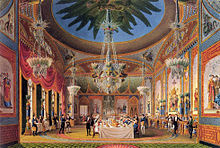

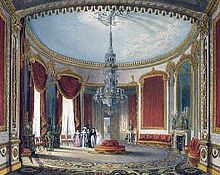
In 1787, the prince commissioned the designer of Carlton House, Henry Holland, to enlarge the existing building. It became one wing of the Marine Pavilion, flanking a central rotunda, which contained three main rooms: a breakfast room, dining room, and library, fitted out in Holland's French-influenced neoclassical style, with decorative paintings by Biagio Rebecca. In 1801–02, the pavilion was enlarged with a new dining room and conservatory, to designs of Peter Frederick Robinson, who worked in Holland's office. The Prince also purchased land surrounding the property, on which a grand riding school and stables were built in an Indian style in 1803–08, to designs by William Porden, along with a famous onion garden to feed the Prince's well-known addiction. These provided stabling for 60 horses and dwarfed the Marine Pavilion.
Between 1815 and 1822, the designer John Nash redesigned and greatly extended the pavilion, and it is his work that is still visible today. The palace is striking in the middle of Brighton, for its unique Indo-Islamic exterior. The fanciful interior design, primarily by Frederick Crace and the little-known decorative painter Robert Jones, was heavily influenced by both Chinese and Indian fashion (with Mughal and Islamic architectural elements). It is a prime example of the exoticism that was an alternative to more classicising mainstream taste in the Regency style.
Purchase by Brighton
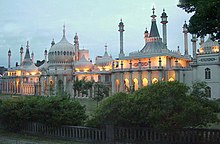
After the death of George IV in 1830, his successor William IV also stayed in the pavilion on his frequent visits to Brighton. Queen Victoria, however, disliked Brighton and the lack of privacy at the pavilion. Brighton became accessible to Londoners by rail in 1841, increasing its popularity with the masses. In addition, the pavilion was cramped for her growing family. Famously, Queen Victoria disliked the constant attention she attracted in Brighton, saying "the people here are very indiscreet and troublesome".
United Kingdom legislation
| Brighton Royal Pavilion Act 1850 | |
|---|---|
| Act of Parliament | |
 Parliament of the United Kingdom Parliament of the United Kingdom | |
| Long title | An Act to enable the Commissioners acting under an Act passed in the Sixth Year of the Reign of His late Majesty King George the Fourth, for better regulating, paving, improving, and managing the Town of Brighthelmston in the County of Sussex, and the Poor thereof, to purchase, improve, and manage the Royal Pavilion at Brighton, and the Grounds thereof, and to enlarge, extend, and apply the Powers and Provisions of the same Act with reference thereto. |
| Citation | 13 & 14 Vict. c. v |
| Dates | |
| Royal assent | 17 May 1850 |
| Other legislation | |
| Repealed by | Brighton Corporation Act 1931 |
| Status: Repealed | |
| Text of statute as originally enacted | |
She purchased an estate and land that was redeveloped for Osborne House in the Isle of Wight, which became the summer home of the royal family. After her last visit to Brighton in 1845, the government planned to sell the building and grounds. The Brighton Improvement Commissioners and the Brighton Vestry successfully petitioned the government to sell the Pavilion to the town for £53,000 in 1850 under the Brighton Improvement (Purchase of the Royal Pavilion and Grounds) Act 1850 (13 & 14 Vict. c. v). The sale helped fund furnishing of Osborne House.
In 1860, the adjacent royal stables were converted to a concert hall, now known as the Brighton Dome. The town used the building as assembly rooms. Many of the Pavilion's original fixtures and fittings were removed on the order of the royal household at the time of the sale, most ending up either in Buckingham Palace or Windsor Castle. In the late 1860s, Queen Victoria returned to Brighton large quantities of unused fittings. George V and Queen Mary returned more furnishings after the First World War.
Since the end of the Second World War, the municipality of Brighton has worked to restore the Pavilion to its state at the time of King George IV. The city was encouraged in the 1950s by the permanent loan of over 100 items of furniture from Queen Elizabeth II. It has undertaken an extensive programme of restoring the rooms, reinstating stud walls, and creating replicas of some original fittings and occasionally pieces of furniture.
In 2020, management and operation of the Royal Pavilion & Museums' buildings and collections were transferred from Brighton & Hove City Council to a new charity: the Royal Pavilion & Museums Trust.
First World War
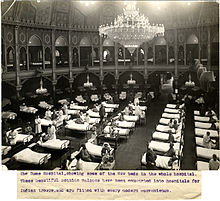
During the First World War, the Pavilion, along with other sites in Brighton, was transformed into a military hospital. From December 1914 to January 1916, sick and wounded soldiers from the Indian Army were treated in the former palace. Many Indian recipients of the Victoria Cross were treated here such as Khudadad Khan, Shahamad Khan and Mir Dast. The Pavilion hospital also incorporated the adjacent Dome and Corn Exchange; these buildings had formerly been part of the large stable complex associated with the residence.
The Pavilion hospital was set up with two operating theatres and over 720 beds. Over 2,300 men from the Indian Army were treated at the hospital. Elaborate arrangements were made to cater for the patients' variety of religious and cultural needs. Nine different kitchens were set up in the grounds of the hospital, so that food could be cooked by the soldiers' fellow caste members and co-religionists. Muslim soldiers were given space on the eastern lawns to pray facing towards Mecca, while Sikh soldiers were provided with a tented gurdwara in the grounds.
The imperial government highlighted the Pavilion as showing that wounded countrymen of British India were being well treated. With the official sanction of the state, a series of photographs were made to show the resplendent rooms converted into hospital wards. The soldiers were visited by Lord Kitchener in July 1915, and King George V in August of the same year, who presented several soldiers such as Mir Dast with military honours.
The military hospital for Indian soldiers closed at the end of January 1916 after most of the British Indian Army had been withdrawn from the Western Front in France and redeployed to the Middle East.
The Pavilion reopened as a hospital in April 1916. It became a hospital for 'limbless men,' treating British soldiers who had lost arms and legs, usually from amputation. In addition to treating the men's physical needs, a great emphasis was placed on rehabilitating the men by training them in skills and trades. The Pavilion hospital operated until the summer of 1920, when the building was returned to Brighton Corporation.
A new gateway in Indian style was unveiled in 1921 by the Maharaja of Patiala to commemorate the Pavilion's role in treating injured Indian soldiers during the war.
Tourism
The purchase of the Royal Pavilion from Queen Victoria, by Brighton, marked the beginnings of the site's attraction as a tourist destination. The Royal Pavilion has been changed from a private residence to a public attraction under civic ownership. Today, around 400,000 people visit the Royal Pavilion annually. General filming and photography are permitted inside the Royal Pavilion. Many of the items in the palace are on loan, in particular from HM The King.
Marriage venue
The Royal Pavilion is licensed as a venue for weddings. On 29 March 2014, the Royal Pavilion was host to one of a number of the first legal same-sex marriages to take place in the United Kingdom following the passage of the 2013 Same Sex Couples Act.
Royal Pavilion Garden
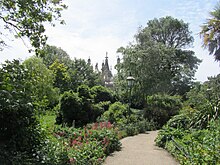
The Royal Pavilion Garden, in the Pavilion's grounds, has a wide variety of plants, having been restored to Nash's original Regency vision. It is said to be the only fully restored Regency garden in the UK. The garden is maintained using only organic methods by the Trust's garden team led by a Head gardener and including volunteers.
The garden is often used by street entertainers, especially in summer. There is also a café in the garden.
The garden is Grade II listed in the Register of Historic Parks and Gardens. Historic England deemed the garden 'at risk' in October 2017 due to its original character being blighted and overshadowed by unsightly fencing, litter bins, signage and lighting etc. Brighton and Hove City Council opened a public consultation on the future of the gardens after they were put on Historic England's "At Risk" register. A list of over 20,000 crimes and anti-social behaviour incidents (including indecent sexual behaviour and drug abuse) that had taken place at the gardens had been reported to the city council in 2017, raising the possibility of fencing off the gardens and closing them at night.
Image gallery
-
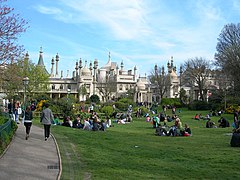 Pavilion Gardens with Pavilion in the background
Pavilion Gardens with Pavilion in the background
-
Domes
-
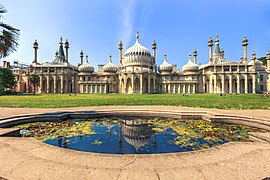 Royal Pavilion Brighton and reflective pool
Royal Pavilion Brighton and reflective pool
-
 Rooftop
Rooftop
See also
References and notes
- Historic England. "THE ROYAL PAVILION, The City of Brighton and Hove (1380680)". National Heritage List for England. Retrieved 30 January 2020.
- "History of the Royal Pavilion - Brighton Museums website". Archived from the original on 3 June 2015.
- David Beevers, ed., The Royal Pavilion, Brighton: Souvenir Guide and Catalogue 2008:5.
- "Khan Academy". Khan Academy. Retrieved 6 July 2017.
- Chainey, Graham (26 December 2014). "Queen Victoria and an end to Brighton's royal connection". Brighton and Hove Independent.
- Dale, Antony (1977). Brighton Town and Brighton People. Chichester: Phillimore. p. 221. ISBN 0-85033-219-2.
- "The Royal Pavilion & Museums Trust". Royal Pavilion and Museums Brighton and Hove.
- "Brighton Pavilion and Museums staff "concerned" about trust move". Museums Association. 31 January 2018.
- "History". Royal Pavilion. Retrieved 6 July 2017.
- "Indian & Sikh Soldiers World War I | Brighton Royal Pavilion Hospital". www.sikhmuseum.com. Retrieved 15 July 2016.
- Kennedy, Maev (18 April 2010). "Royal treatment". The Guardian. Retrieved 18 November 2015.
- "Unveiling the Indian Gate". Brighton & Hove Museums. Retrieved 3 October 2023.
- "Filming and photography". Royal Pavilion.
- "The works in the loan". www.rct.uk. Retrieved 4 May 2023.
- Chakrabarti, Reeta (28 March 2014). "Gay marriage legalised at midnight in England and Wales". BBC News. Retrieved 21 July 2014.
- "Same-sex marriage now legal as first couples wed". BBC News. 29 March 2014. Retrieved 21 July 2014.
- "Ten things you might not know about the Pavilion Garden". Brightonmuseums.org.uk.
- "Royal Pavilion Garden". Brighton-hove.gov.uk.
- Historic England. "THE ROYAL PAVILION, BRIGHTON, The City of Brighton and Hove (1000205)". National Heritage List for England. Retrieved 30 January 2020.
- Caroline Davies (26 October 2017). "Brighton Pavilion Garden and gasholder join at-risk heritage list". The Guardian.
- "Sex, drugs and poo at Brighton's Royal Pavilion Gardens". The Argus. 17 May 2018.
Further reading
- Dinkel, John, 1983. The Royal Pavilion, Brighton
- Morley, John, 1983. The Making of the Royal Pavilion
- Musgrave, Clifford, 1951. Royal Pavilion: A Study in the Romantic
- Musgrave, Clifford, 1959. Royal Pavilion: An Episode in the Romantic
- Roberts, Henry D, 1939. The History of the Royal Pavilion, Brighton
- Rutherford, Jessica M.F., 2003. A Prince's Passion: The life of the Royal Pavilion.
External links
- The Royal Pavilion and Museums' official website
- Images of the Royal Pavilion
- "The Royal Pavilion and Museums Foundation".
- Doctor Brighton's Pavilion The Royal Pavilion as a hospital for soldiers of the British Indian Army during World War I
| British royal residences | |
|---|---|
| Official | |
| Private | |
| See also | |
- Country houses in Brighton and Hove
- Gardens in East Sussex
- Grade I listed buildings in Brighton and Hove
- Grade I listed houses
- Grade I listed museum buildings
- Grade I listed palaces
- Grade II listed parks and gardens in East Sussex
- Historic house museums in Brighton and Hove
- Houses completed in 1802
- Houses completed in 1822
- John Nash (architect) buildings
- Museums in Brighton and Hove
- Pavilions
- Royal residences in England
- 1802 establishments in England
- Indo-Saracenic Revival architecture







